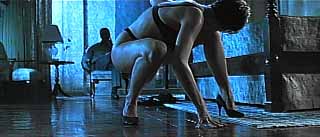|
New Histories, New Modes of Spectatorship
Weirdly enough, I found some answers in current academic film history. I say "weirdly enough" because I'd just about given up on academic film criticism; too much of it relied on unsubstantiated Lacanian psychoanalysis and unreadable, jargon-riddled prose.

Natural Born Killers (1994, Warner Home Video)
But this new historical scholarship combines factual research and interpretive theory in accessible and enlightening ways.
By looking closely at the interactions between media texts, spectators, and historical and ideological contexts, critics like David Bordwell, Janet Staiger, Henry Jenkins, Richard Dyer, Lea Jacobs, Tom Doherty and others offer useful frameworks for understanding how films (and, by extension, other types of media) affect audiences. The new historians' areas of emphasis--text, spectator, context--quite nicely address the issue of violence:
- What role do individual films and TV programs play in influencing spectator reactions? You talk as if all violent films are the same, Bob, but that's ridiculous. I can identify a truckload of contemporary horror movies, for instance, that do a lot more than just serve up steaming viscera.
What about the broadsides against consumerism in Dawn of the Dead, or the trenchant critiques of the media in Piranha and The Howling? (Robin Wood makes some sharp observations about the contemporary horror film in Hollywood from Vietnam to Reagan.) Horror films, like other violent fare, can be culturally and artistically significant; evaluations like this need to be made on a film-to-film basis, person-to-person basis, and not through a simplistic denunciation of all media violence.
- Where do spectators fit into all this? Bob, the automatic connection you draw between media and real-life mayhem ignores the complexity and subjective nature of audience-film relationships. Why do you watch a TV show or movie? To see exploding cars and other property damage? To escape the work-a-day grind? To dream about attractive stars? To catalog the newest entry in a beloved genre? To watch cool special effects? To encounter the personal vision of the auteur(s) responsible for the film? Chances are your reasons are an unruly mixture of these and a hundred more, some of which reflect your personal desires and others that you've picked up from your family, education, and exposure to other media. Janet Staiger calls these preferences reading strategies, and argues that individual spectators often exercise contradictory reading strategies while watching a film. As Staiger writes, "As a student of Hollywood cinema, I find Raiders of the Lost Ark a masterpiece of filmmaking, but as a feminist I am appalled." I teach feminist films while I admire the aestheticism of the murder-by-stabbing-and-hanging at the beginning of Suspiria.

True Lies (1994, FoxVideo)
And I can imagine you, Bob, sitting in front of the TV, knowing that you shouldn't be watching Baywatch but compulsively thinking about that Pamela Anderson Lee in a bikini...
- What is the role of environment in audience response? It seems like common sense to claim that where and how you saw a movie affects your reception. These effects are sometimes pretty prosaic; maybe you hated seeing Batman at the multiplex because a guy behind you kept loudly rustling his popcorn bag, but this has nothing to do with the film. But what if you saw Halloween as part of a college course on gender and contemporary film? Or what if you watched Bloodsucking Freaks in a sticky-floor grindhouse with a male audience that exhibited undue relish over the film's numerous killing scenes? Do teenage kids take horror films seriously, or do they establish a healthy distance between themselves and movies like Freddy's Dead: The Final Nightmare? Do films like Natural Born Killers have more violent power on the big screen or on video? These are significant questions, and Jeff Sconce, Carol Clover, Tim Corrigan, and other critics have taken the first steps towards answering them. Check out what they say before you make the "violent film" issue a big theme of your campaign, Bob.
Target: McDonalds, or: All Effects are Local
As far as I'm concerned, this complex web of film, spectator and context makes all responses to texts as sloppy, complicated, and contradictory as my own to violent movies. This sloppiness invalidates your one-on-one correlation between visual and audience effects, Bob, and it also defines the study of media effects as a troublingly inexact endeavor. I don't believe we can ever adequately understand media effects on audiences, since response depends so heavily on the subjectivities of each individual spectator, who--due to race, class, gender, intellectual training, conditions of reception, notions of pleasure, and a thousand other personal factors--may or may not be predisposed to consider a film or TV show "good" or "bad," or "capable of riling up a postal worker enough to go out and open fire at McDonalds." All media effects are local, and a reliable model of audience response should acknowledge that a number of responses (perhaps an infinite number) are possible to any artwork in a given historical moment.
This doesnít mean, however, that spectator interpretation is a model democracy or a perfectly level playing field. The idea of "bounded interpretation"--as forwarded by Staiger, Richard Dyer, and other scholars--makes some sensible points about the question of media influence. As Dyer writes,
We are all restricted by both the viewing and the reading codes to which we have access (by virtue of where we are situated in the world and the social order) and by what representations there are for us to view and read. The prestige of high culture, the centralization of mass cultural production, the literal poverty of marginal cultural production: these are aspects of the power relations of representation that put the weight of the control over representation on the side of the rich, the white, the male, the heterosexual.
In other words: rich, white, straight guys (your homeys, Bob!) run the media, and thus have an inordinate power in determining reading strategies. But as Staiger reminds us, these elites havenít fully colonized the subconscious of the mass audience; smaller, more subversive reading strategies percolate beneath the orthodoxy of mass opinion, occasionally surfacing as weird rumors, conspiracy theories or downright insurrection. Even though certain reading strategies and subject positions are dominant in any given historical moment, but there's always the possibility for oppositional positions too. And all these different ways of looking at TV shows, watching movies, and listening to CDs lead to multiple responses and effects.
So I think youíre way off-base, Bob, in your assumption that the wanton sex and violence portrayed in the media is debasing our nation and threatening our children. The situation is just too complex to fit into easy generalities. You and me and everybody else, weíre all figuring out personal answers about how we've been influenced by the media. Iíll keep trying to understand my attraction to violent movies as long as you promise not to censor culture in defense of the American "character," deal? I canít help but think that the mingling of multiple reading strategies with various forms of violent and non-violent entertainment creates a productive chaos, a multifaceted society where all viewpoints receive an airing and none are suppressed. A utopia it ainít, but home it is.
Best,
Craig Fischer
Craig Fischer is one of the
editors of Cinema Journal. He also teaches English at the University of
Illinois.
page 3 of 3

|





























